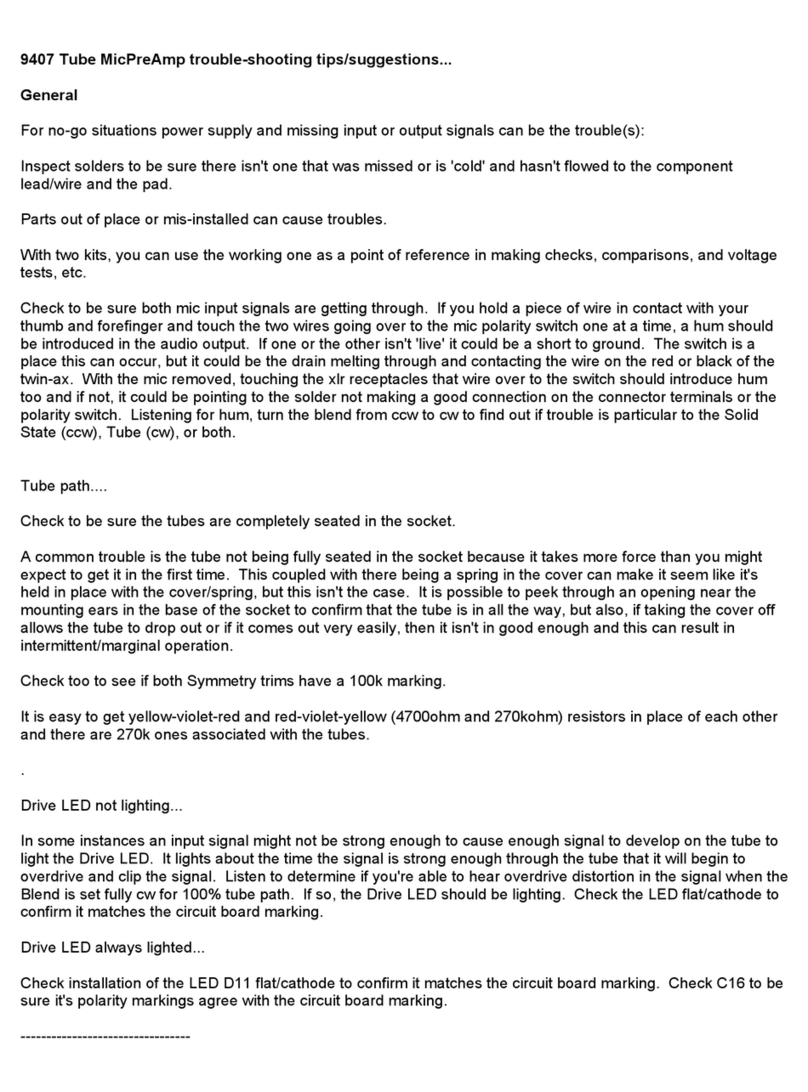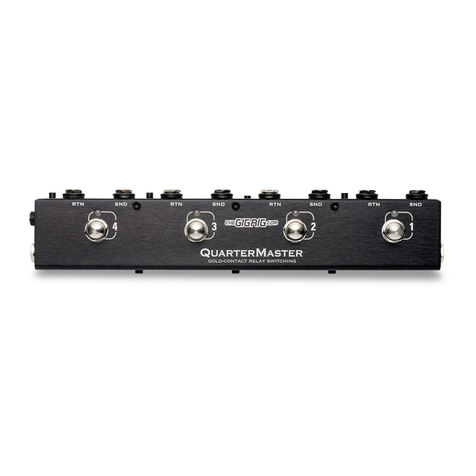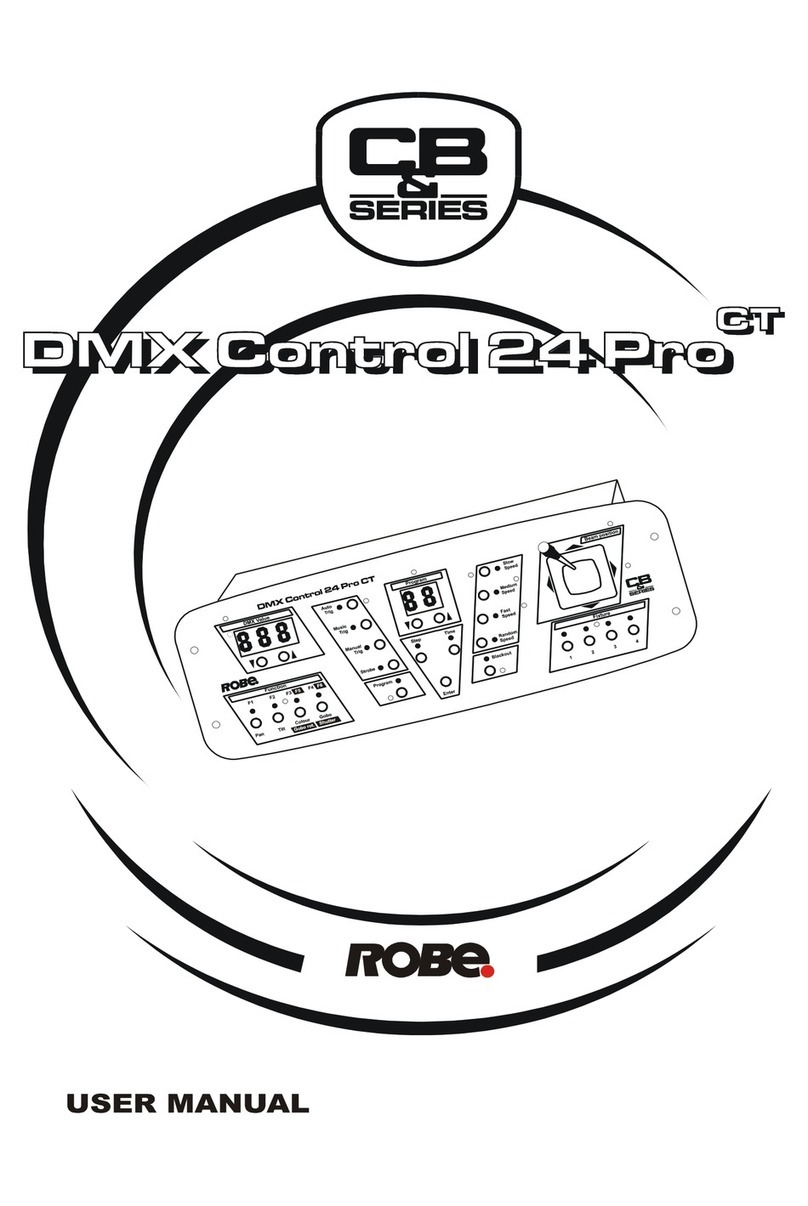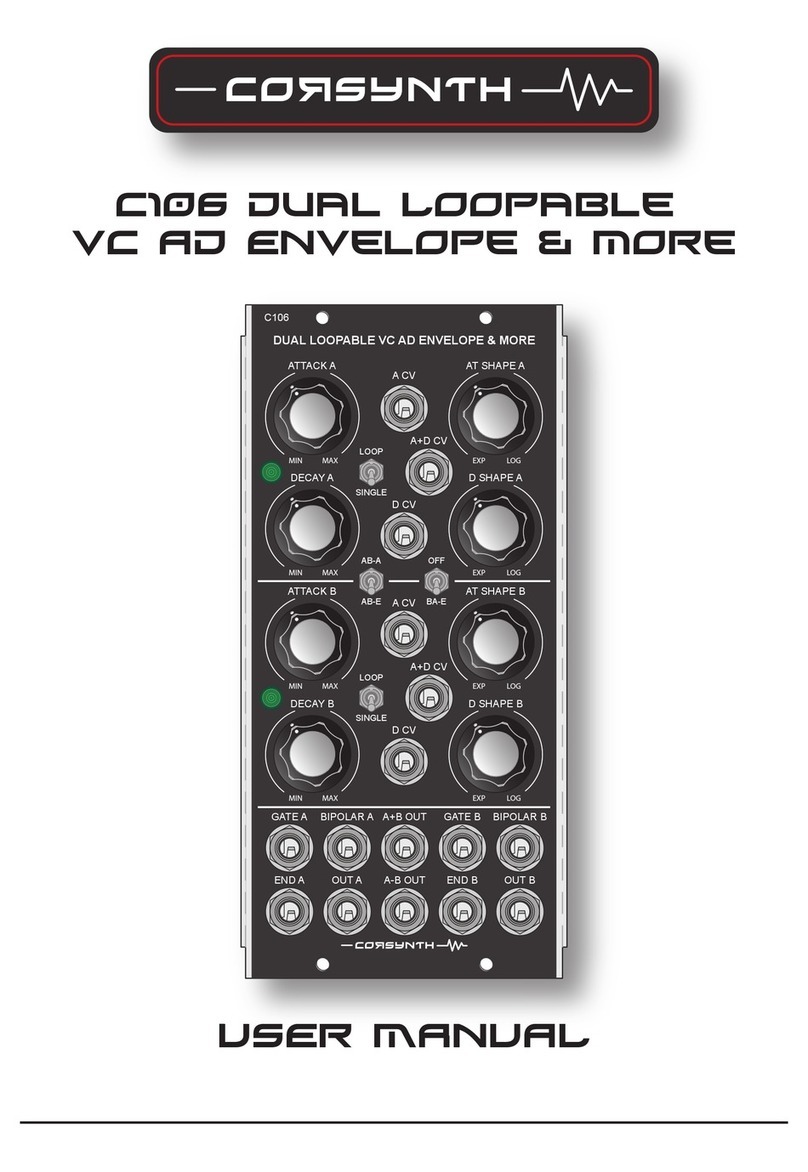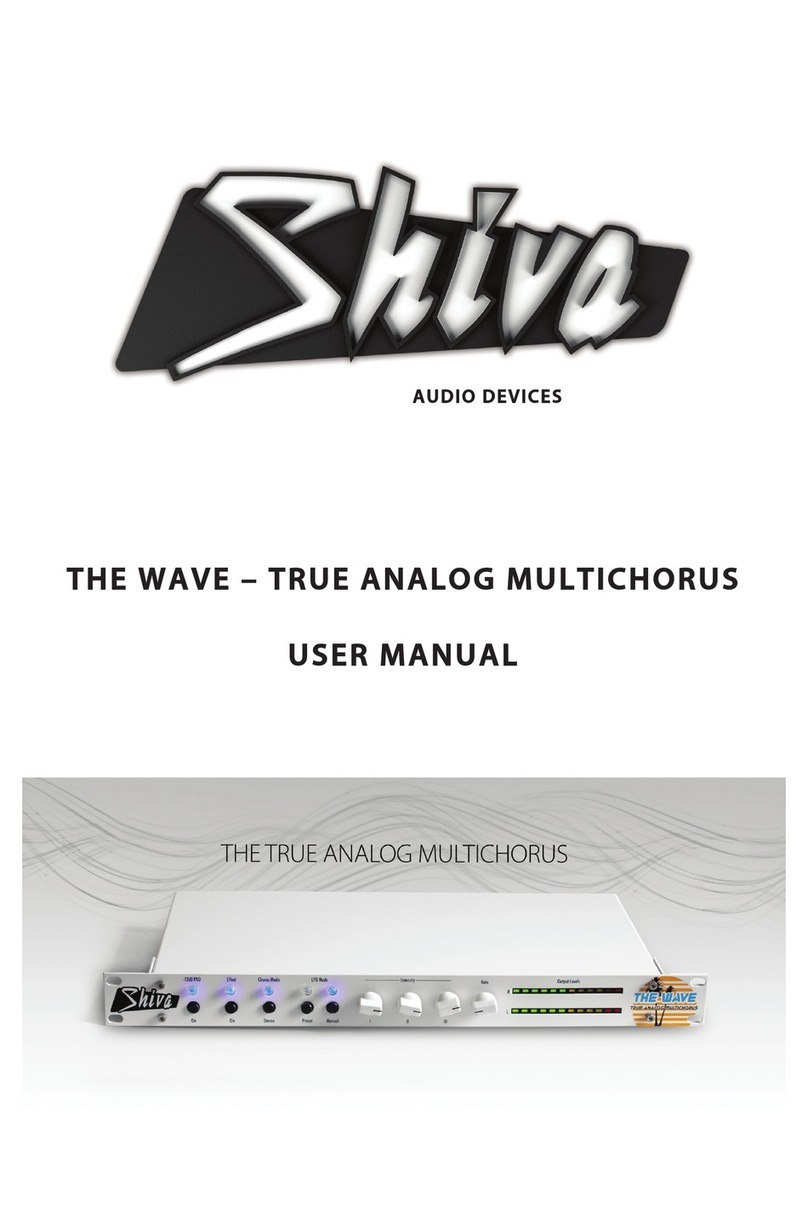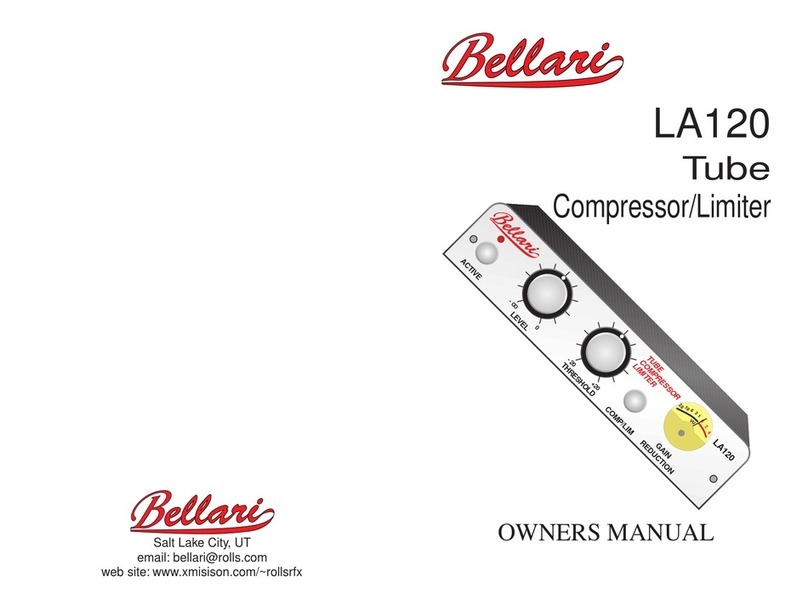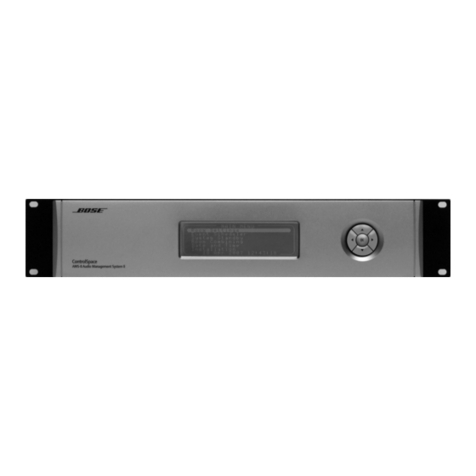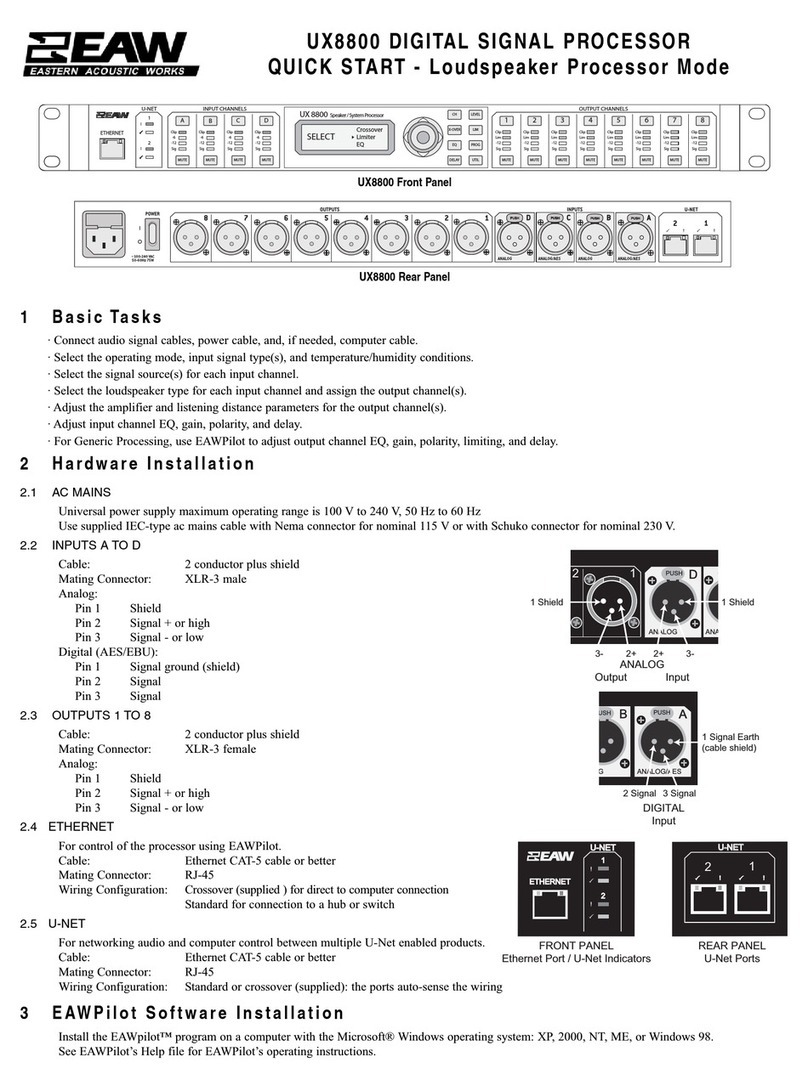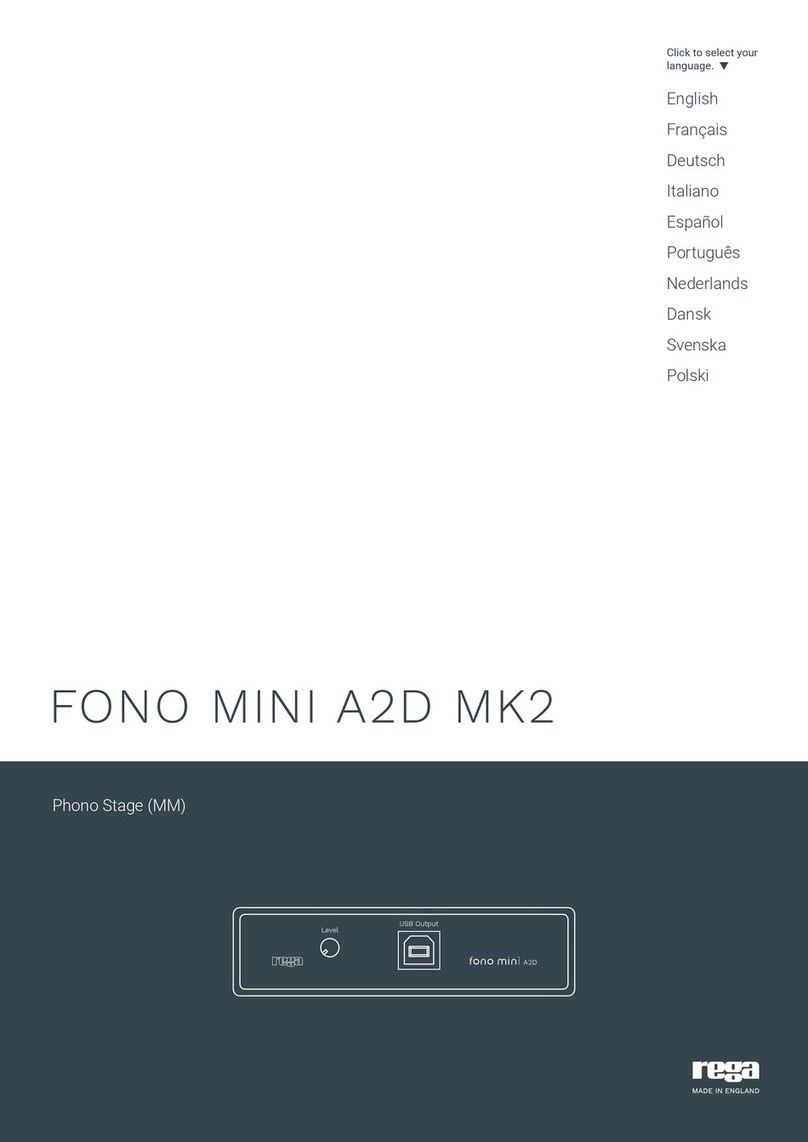tech21 Fly Rig RK5 v2 User manual

POWER REQUIREMENTS
Utilizes included 9V DC, 100-240V universal auto-switching power
supply, 200mA minimum, center negative. Tech 21 Model #DC9.
NOTE: See page 3 for instructions how to change the prong
assembly for countries outside the US.
For replacements, contact your local dealer/distributor, or Tech 21.
Maximum power consumption of the Fly Rig: approx 150mA.
WARNINGS:
*There are no user-serviceable parts inside. Attempting to repair unit is
not recommended and may void warranty.
*Missing or altered serial numbers automatically void warranty. For
your own protection: be sure serial number labels on the unit’s back
plate and exterior box are intact, and return your warranty
registration card or register online.
Note: This equipment has been tested and found to
comply with the limits for a Class B digital device, pursuant
to part 15 of the FCC Rules. These limits are designed to
provide reasonable protection against harmful interference
in a residential installation. This equipment generates, uses and can radi-
ate radio frequency energy and, if not installed and used in accordance
with the instructions, may cause harmful interference to radio commu-
nications. However, there is no guarantee that interference will not
occur in a particular installation. If this equipment does cause harmful
interference to radio or television reception, which can be determined
by turning the equipment off and on, the user is encouraged to try to
correct the interference by one or more of the following measures:
• Reorient or relocate the receiving antenna.
• Increase the separation between the equipment and receiver.
• Connect the equipment into an outlet on a circuit different from that
to which the receiver is connected.
• Consult the dealer or an experienced radio/TV technician for help.
WARRANTY:
ONE YEAR IMITED. PROOF OF PURCHASE REQUIRED.
Manufacturer warrants unit to be free from defects in materials and
workmanship for one (1) year from date of purchase to the original
purchaser and is not transferable. This warranty does not include dam-
age resulting from accident, misuse, abuse, alteration, or incorrect cur-
rent or voltage. If unit becomes defective within warranty period, Tech
21 will repair or replace it free of charge. After expiration, Tech 21 will
repair defective unit for a fee.
REPAIRS:
A REPAIRS for residents of U.S. and Canada: Call Tech 21 for
Return Authorization Number. Manufacturer will not accept
packages without prior authorization, pre-paid freight (UPS preferred)
and proper insurance. International residents should contact our local
distributor, which can be found on the Support page of our website.
FOR PERSONA ASSISTANCE & SERVICE:
Contact Tech 21 weekdays 10:00 AM to 5:00 PM, EST: 973-777-6996.
Han -built in the U.S.A. using high-quality components
sourced domestically and around the globe.
T: 973-777-6996 • F: 973-777-9899
E: info@tech21nyc.com • www.tech21nyc.com
©2018 Tech 21 USA, Inc. (Rev 8.19)

TECH 21, THE COMPANY
Tech 21 was formed by a guitarist possessing the unusual combination
of a trained ear and electronics expertise. In 1989, B. Andrew Barta
made his invention commercially available to players and studios around
the world. His highly-acclaimed SansAmp™ pioneered Tube Amplifier
Emulation in professional applications for recording direct and perform-
ing live, and created an entirely new category of signal processing. There
have since been many entries into this niche, yet SansAmp continues to
maintain its reputation as the industry standard.
With a full line of SansAmp models, Tech 21 also offers effect pedals
and MIDI products, as well as “traditional” style amplifiers for guitar and
bass. Each product is thoughtfully and respectfully designed by B. An-
drew Barta himself with the player in mind. Our goal is to provide you
with flexible, versatile tools to cultivate, control, refine and redefine
your own individual sound. Tech 21 takes great pride in delivering con-
sistent quality sound, studio to studio, club to club, arena to arena.
PRODUCT OVERVIEW
A Tech 21 Fly Rig is much more than a pedalboard. In a single pedal. And
no board. Less than 13 inches long and weighing just over 20 oz., this
sleek, compact unit embodies an entire rig. At the heart, is the all-analog
SansAmp, which makes it possible to go direct to a PA or mixer. For ef-
fects, you have all the essentials and some fun stuff, too. What you don’t
have are crackling patch cables, dying batteries or ground loops. No
stinkin’ van, heavy flight cases, cable spaghetti, and no dead weight.
With a Tech 21 Fly Rig, you can relax. For fly gigs across the globe, jam-
ming at the local hang, and last minute sessions, you’ll be the first one
ready to go. You can stop stressing over what to pack and agonizing over
what to leave behind. You can stop dreading cheesy backline loaners and
overheating at the mere thought of your touring rig going down. Just
pop your Fly Rig into your guitar case or backpack and head for the
door. (Be sure to wipe that smile off your face when the rest of the band
shows up sweating and out of breath.)
RICHIE KOTZEN RK5 v2 SIGNATURE FLY RIG
The Richie otzen R 5 Signature Fly Rig was developed in close collab-
oration with Richie, whose input was invaluable. Meticulous about
every facet of his playing, singing, songwriting and tone, Richie’s atten-
tion to the details of his R 5 was nothing less.
Since the debut of the original R 5 in 2014, Richie’s needs have
changed, both on and off the road. Therefore, we jointly developed a
version 2, to incorporate some new features and follow the same form
as later Fly Rigs, such as the Bass and Acoustic.
The R 5 v2 retains the same delay with tap tempo, a powerful boost,
and Richie’s Signature OMG overdrive. New features include an inde-
pendent reverb with choice of room size, a rotary speaker mode, com-
pression, fuzz, a tuner, headphone capability and an XLR Output.
Another difference is an on/off button for the SansAmp section. Richie
previously would use his R 5 both with and without the SansAmp en-
gaged. Now he keeps it on all the time, so he no longer needs a dedi-
cated footswitch. For live performances, with ever-changing backlines, he’s
able to get his tone and at lower volume. On Richie’s latest releases, The
Damned and Riot, all the guitars were recorded direct.
If you’ve seen Richie on tour in recent years (and if you haven’t, you sim-
ply must), you may have noticed he uses two R 5s. He has continued this
practice with Version 2 so he can quickly switch between different set-
tings of each of the effects.
Richie is actively involved and responsive in the entire design process.
Having both a working and personal relationship with Richie, is a tremen-
dous highlight in our history.
APPLICATIONS
As a PRE-AMP or STOMPBOX with a guitar amp. You can
connect the R 5 in-line just as you would a standard distortion pedal. If
the pre-amp of your amplifier is imparting too much of its own charac-
ter on the pedal, plug into the low level input and set the pre-amp as
clean and neutral as possible. As most amps tend to be on the bright
side, you may need to start with High in the SansAmp section below
12 o’clock and adjust as necessary.
Also, be aware that most tube amps have a tone stack. When every-
thing is on max, they tend to cut the mid range. So don’t be surprised
to find that the flattest sound is achieved with bass and treble at mini-
mum, and mid at max. Since most tube amp passive tone stacks work in
a similar fashion, we recommend this as a good starting point and ad-
justing to taste.
You can also plug into the effects loop return (if the amp has one). This
will disable the entire pre-amp of the amp for a truer representation of
the pedal’s sound.
For DIRECT RECORDING or DIRECT to PA. All of the tone
shaping and cabinet emulation needed is already incorporated into the
SansAmp section of the pedal. It can be plugged into mixers (live and
studio), workstation/recorders, and even directly into the sound card
on a computer.
GOOD TO KNOW BEFORE YOU START
SIGNA F OW OF THE RICHIE KOTZEN RK5 v2 F Y RIG
SET EVE CONTRO S FOR UNITY GAIN
Set the level controls so you have the same volume coming from your
speaker/monitor whether the pedal is active or in bypass. This ensures
the next device in the signal chain won't get slammed by a much hotter
signal than what would normally come from the instrument. Similarly,
you wouldn't want a drop in volume either, which would force the next
device to struggle for enough signal.
NOTE: When running the R 5 Output directly to the PA, set the
SansAmp Levels fairly high to achieve the best signal-to-noise ratio.
SET ALL OTHER CONTROLS AT NOON, just to get started.
CLIP WARNING
The Level control in the Delay section has a built-in clip warning. Like a
VU meter, it will flash red to warn you if the Fly Rig is being over-
loaded.
You can then trim the corresponding control accordingly: Boost, OMG
Level or SansAmp Level. Bear in mind that occasional blinks (peaks) are
okay and can be expected when you dig into your strings, but it should
not be continuously lit.
12

RELATIONSHIP OF THE LEVEL CONTROLS
Signal flow is right to left, from the input to the output. Therefore, the
Level controls follow in the same order, from Boost to OMG Level to
SansAmp Level.
Be aware that the “last” level in the signal path will determine the over-
all output level. For instance, when the OMG and SansAmp sections
are engaged, the SansAmp Level determines the overall output level of
the unit. If only the Boost and OMG are engaged, the OMG Level de-
termines the overall output level of the unit.
The Delay Level control only affects the mix level of the delay, not the
overall output level.
UNIVERSAL POWER SUPPLY
The included power supply is pro-
vided with a U.S. prong assembly in-
stalled. To change the prong assembly
to one of the included European, U
or Australia/New Zealand styles, be
sure the power supply is unplugged
and follow these instructions:
Press the PUSH switch to release the
prong assembly. Slide the assembly up
(about halfway) to align the side tabs of
the prong assembly with the slots of
the power supply housing. Then pull up
to remove the assembly. Choose the new prong assembly, align the side
tabs with the slot of the housing and slide down until it clicks into posi-
tion.
NOTE: You cannot slide the prong assembly all the way out.
THE INS AND OUTS
1/4” INPUT: 1megOhm instrument level. For normal operation, sig-
nal level to Input should be close to that of a standard electric guitar
(approx -10dBm / 250mV). The input is designed with the same sensi-
tivity and loading characteristic as a tube amp.
1/4” UNIVERSA OUTPUT: Unbalanced 1kOhm Low Z instru-
ment level output. This output can be connected to High Z guitar ampli-
fiers (or effects) as well as Low Z mixer and computer inputs. Output level
is unity gain when pedal is in bypass mode. It also drives long cables without
loss of signal integrity, even in bypass.
BA ANCED X R OUTPUT & GROUND
CONNECT SWITCH: Balanced low Z output. When the
Ground Connect switch is engaged, the ground connects.
Disengaged, the ground of your stage system and other inter-
connected gear is lifted (isolated) from the ground of the
mixing console.
NOTE: Both outputs can be used simultaneously. For example, 1/4"
Out to your amp and XLR Out to PA mixer, which is one instance
where the Ground might need to be disengaged.
34
!! WARNING !! DO NOT RUN THE SPEAKER OUT-
PUT OF ANY AMP directly into a Fly Rig/SansAmp
input. Severe damage will result.
GUIDE TO FUNCTIONS an CONTROLS
(in order of signal flow)
BOOST & COMP Section
BOOST: Independent pre-Boost for
solos, up to approx 12dB.
COMP Switch: Utilizes old school, all-
analog, FET-based technology from the ‘50s
and ‘60s, which is inherently warmer, more
transparent and more musical than other
methods of compression.
EVE : Adjusts the output level of the
Boost section.
OMG Overdrive Section
Based upon the Richie otzen Signature OMG pedal, this section pro-
vides a wide range of overdrive, from clean to aggressive. You can add
personality to a clean amp or use it for extra punch with a dirty amp
tone.
DRIVE: Adjusts the overall amount of
gain and overdrive, similar to when the
output section of a tube amp is being
pushed. Highly interactive with the level of
your guitar. For instance, you can clean up
the amount of distortion by decreasing the
guitar’s volume (except in very extreme
settings) without having to change the set-
ting on the pedal. Conversely, you can in-
crease the amount of distortion by simply
increasing the guitar’s volume.
TONE: Specialized voicing for adjusting
the high-end and mid-range of the OMG
section. As you reduce the setting, it will
decrease the high-end without losing mids
or getting muddy. At max, it’s flat.
EVE : Adjusts the output level of the OMG section.
FUZZ Switch: Changes the character and attack of the overdrive
to a fuzz-style tone, making it thicker and woolier.
NOTE: The OMG section is an effect. It has no speaker emulation in-
corporated into the circuitry and is not designed or intended to be
used alone going direct to a mixer or PA.

SANSAMP Section
The SansAmp technology enables the R 5 to run directly into mixers of
recording desks and PA systems, as well as augment your existing ampli-
fier set-up. It can also be used to record directly and enhance previously
recorded tracks. The SansAmp section of the R 5, focuses on clean
tones within the tube amplifier sound spectrum. To dirty things up, you
have the flexibility of using the Drive control, the Boost function, or you
can add overdrive from the OMG section. Or all three. Each method
achieves different tones.
Note: Richie keeps the SansAmp section on when going direct and typi-
cally turns it off when using an amp.
DRIVE: Adjusts the overall amount of gain and overdrive, similar to
when the output section of a tube amp is being pushed. The first half of
the rotation will increase the volume as well as the overdrive.
OW, MID, HIGH: On-board post-EQ section gives you full con-
trol, like having a studio mixing board at your fingertips. Unlike passive
tone controls that only cut, these active controls cut and boost. At 12
o’clock, they are flat.
LOW is tuned to ±12dB @ 120 Hz.
MID is tuned to ±12dB @ 500 Hz.
HIGH is tuned to ±12dB @ 3.3 kHz.
EVE : Adjusts the output level of the unit when the SansAmp sec-
tion is engaged. This control has an exceptionally wide range for maxi-
mum compatibility with a variety of equipment.
evel Tip: When running the R 5 Output directly to the PA, set the
SansAmp Level fairly high to achieve the best signal-to-noise ratio.
REVERB and DE AY Sections
REVERB
Independent footswitchable reverb features a single, continuously-vari-
able control. It provides a smooth, full sweep to easily dial-in the amount
of reverb desired. Choose between “rooms” via the Size switch:
Out position = Small room. In position = Large room.
56
DE AY
The delay is voiced for the sounds of a vintage tape echo.
TIME: Controls the amount of delay. This single, continuously-vari-
able control provides a smooth, full sweep, ranging from 28 millisec-
onds up to 1,000 milliseconds. At 12 o’clock, Time is approx 300
milliseconds. You can easily dial in the exact amount of delay desired
with one turn of the knob. Turning the Time control while playing will
transpose the pitch of your guitar note, just like a vintage analog delay.
DRIFT: Rather than evenly modulating the delayed signal, Drift adds
a random, unpredictable element to the modulation that is more true
to a vintage tape echo. At minimum (7 o’clock), there is no effect. At
maximum, there will be a drastic shifting of the pitch, which can be
used for special effects.
REPEATS: Feeds back the delayed signal to the input of the delay cir-
cuit to generate the number of repeats. At minimum (7 o’clock), you will
hear one repeat. As you increase the setting, the repeats will follow ac-
cordingly until they are almost infinite. At max, it will self-oscillate.
Repeats Tip: When using the Delay in front of an amp, the amp will
compress the signal and the repeats will become more pronounced.
Therefore, you will most likely need to have the setting lower than you
would when running through an effects loop. For instance, you may find a
Repeats setting at 10 o’clock through an effects loop will yield 3 repeats.
However, through the front of an amp, you may find a setting of 8 o’clock
will give you the same results.
EVE : Adjusts the output level of the Delay section only. Also func-
tions as a clip warning (see page 2).
TAP TEMPO: Dedicated footswitch makes it simple to just tap in
the delay tempo you want during your performance. Tap Tempo will
override the Time setting (and conversely, turning the Time knob will
override the Tap Tempo). The Tap Tempo works in Bypass so you can
set it ahead of time. A special feature of the Tech 21 Tap Tempo is that
it will not change the pitch of your guitar when you change the pace
from faster to slower or slower to faster. This provides a seamless
transition for on-the-fly adjustments if your drummer drifts.
ROTO
Alters the Delay function to a rotating speaker effect.
Tap Tempo controls the speed, from slow to fast, which ramps up like
the real thing to gradually reach a new speed.
Drift changes from blue to purple to indicate Roto mode and then con-
trols the distance of the virtual mic to the rotating speaker:
At minimum, there is no effect.
At maximum, it adds a tremolo-like effect by modulating
the volume in sync with the tonal modulation.
In Roto mode, Level, Repeats and Time are disabled.

78
OTHER GOODIES
CHROMATIC TUNER
The REVERB/TUNER footswitch engages the chromatic tuner. Simply
hold the footswitch down for one second to engage the tuner, which
will
simultaneously mute the signal path. The LED in the tuner window will
then light up. If the green light is on, you’re in tune. If you’re not, the
red arrows serve as indicators:
Arrow points up = Flat. Raise the pitch.
Arrow points down = Sharp. Lower the pitch.
As you get closer to being in tune, the arrow will blink
faster and turn off when you are in tune. The green light
then comes on and you’re good to go.
When you’re finished tuning, simply hit the footswitch to disengage.
HEADPHONE
Switches the 1/4-inch output into headphone mode to drive both
sides and provide higher powered output.
NOTE: Be sure to disengage when going direct
to a mixing board or amplifier, as it will easily
clip the signal.
NOTEWORTHY NOTES
1) Using the RK5 with a Power Engine 60. Simply connect
the 1/4” output of the R 5 to the 1/4” input of the Power Engine 60.
Be aware the Power Engine 60 utilizes a ground independent trans-
former, which may pick up hum from the auto-switching power supply.
Therefore, the XLR input of the Power Engine 60 should be grounded.
You can make your own grounding plug by modifying a male XLR con-
nector by soldering Pin 1 to Pin 3 and inserting into the XLR input of
the Power Engine 60 per the diagram below.
NOTE: If you’re not into soldering, a Tech 21 grounding plug is avail-
able for purchase. Please see our website Accessories page for details.
2) Using the RK5 with a Power Engine Deuce Deluxe. Sim-
ply connect the 1/4” output of the R 5 to the 1/4” input of the Power
Engine Deuce Deluxe.
3) Using the Fly Rig with headphones. Settings may sound
brighter through the headphones, so simply adjust the controls accord-
ingly. Remember to disengage the switch when going direct
to a mixing board or amplifier, as it will easily clip the signal.
4) Tech 21 controls are unusually sensitive and tend to per-
form well beyond what would be considered “normal.” So you need
not set everything at max to get maximum results. For instance, to
brighten your sound, rather than automatically boosting High all the
way up, try cutting back on Low first.
5) To find the best settings for interacting with your other gear,
you may need to use radically different settings for each individual way
you use it. You need not be discouraged or suspect something is wrong
with the unit. If you’ve got your sound, you’ve simply found the right bal-
ance to complement each individual piece of gear. We recommend you
start with the tone controls at 12 o’clock and cut or boost as necessary.
6) Tech 21 pedals have exceptionally low noise levels.
However, they may amplify noise emanating from the input source. To
minimize noise, we recommend active electronic instruments have the
volume set so that the clip light barely comes on when in Bypass, and
have the tone controls positioned flat. If you need to boost, do so
slowly and sparingly. Also check for pickup interference by moving
your guitar or turning the volume off. Be aware single coil pickups are
more likely to generate noise.
7) Placement notes: The Fly Rig can be treated as an amplifier or
pre-amp when it comes to setting up your signal chain:
Place the following effects BEFORE the Fly Rig:
Phaser/Vibe, Overdrive, Wah.
Place the following effects AFTER the Fly Rig:
Delay, EQ, Flanger, Phaser (yes, after is good, too), Pitch Shifter, Reverb.
8) Buffered bypass eliminates the shortcomings associated with
“true bypass” (pops and clicks, and high-end loss when multiple pedals
are connected together), as well as signal loss associated with other
types of switching circuits.
9) Custom actuators. All Tech 21 pedals feature smooth, custom,
silent-switching actuators.

910

11 12

13 14
This manual suits for next models
1
Table of contents
Other tech21 Music Equipment manuals

tech21
tech21 SansAmp Geddy Lee MP40 Limited Edition User manual
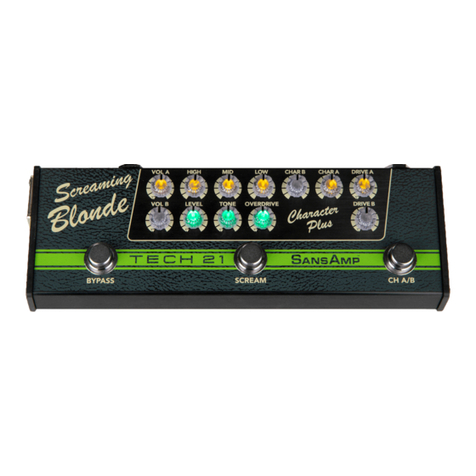
tech21
tech21 Character Plus Series User manual
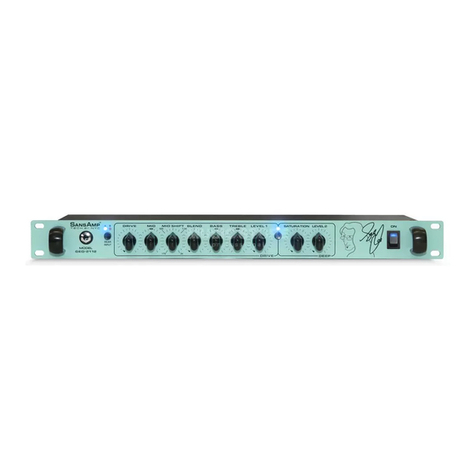
tech21
tech21 SansAmp GED-2112 User manual
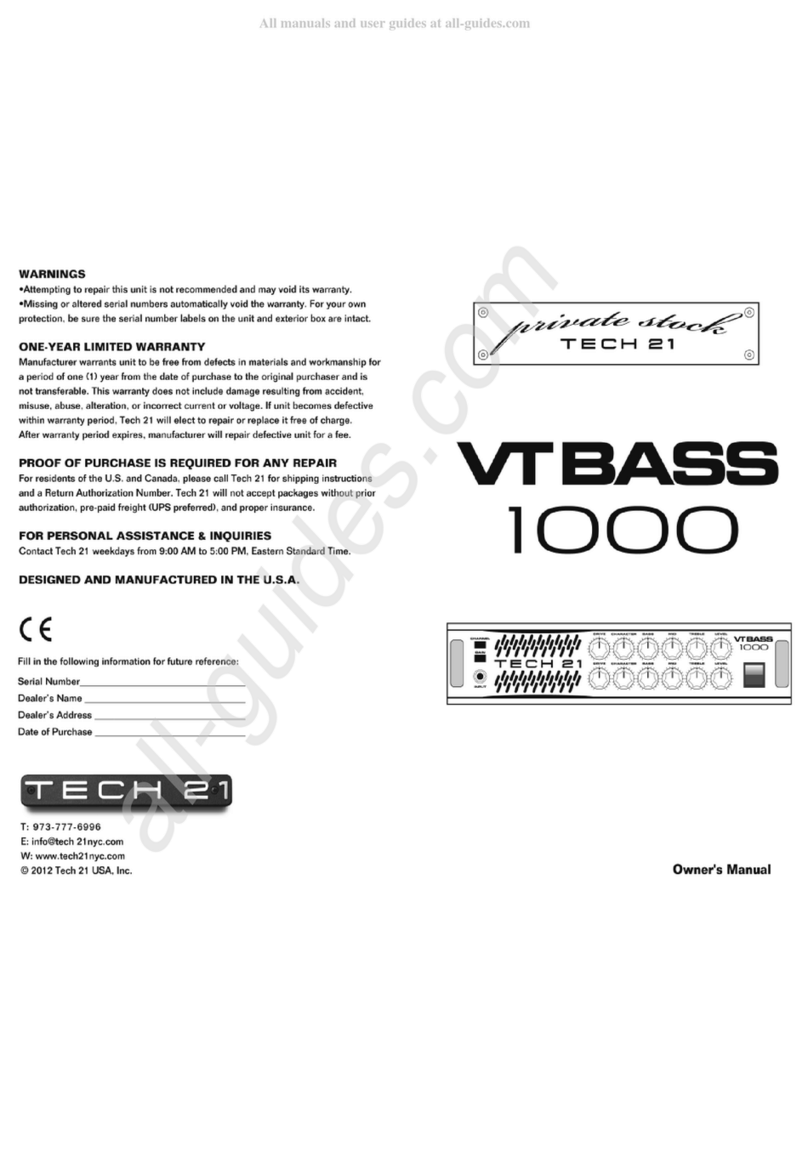
tech21
tech21 VT Bass 1000 User manual
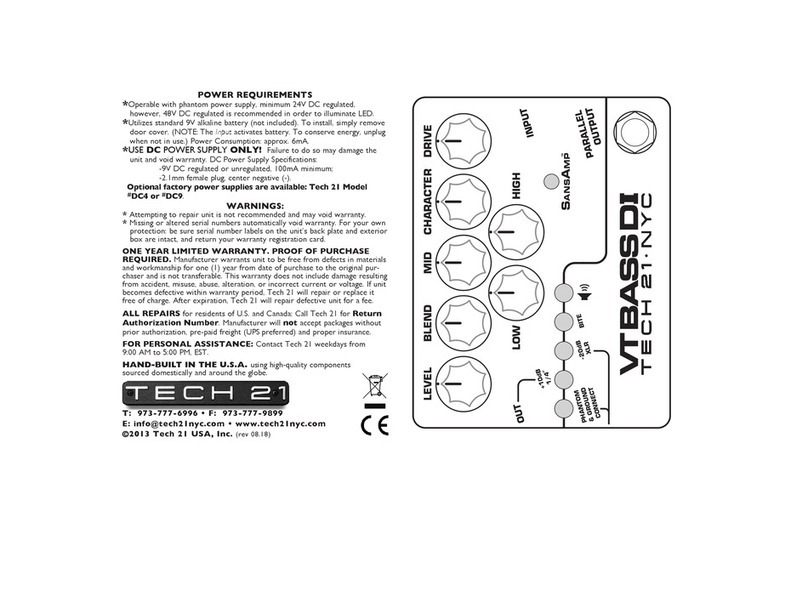
tech21
tech21 BSDR2-OM User manual
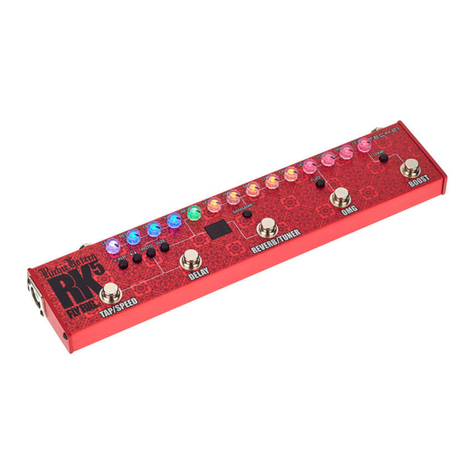
tech21
tech21 Richie Kotzen RK5 Fly Rig User manual
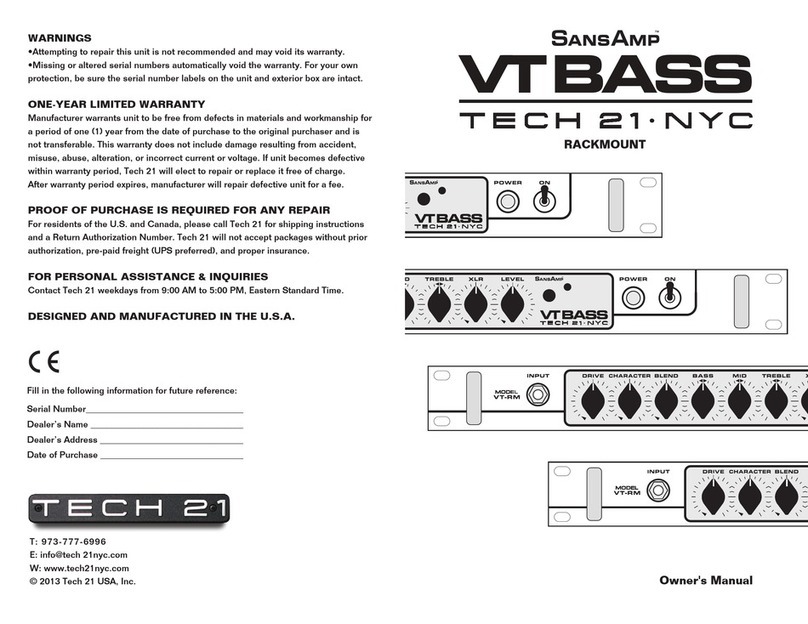
tech21
tech21 SansAmp VT BASS User manual
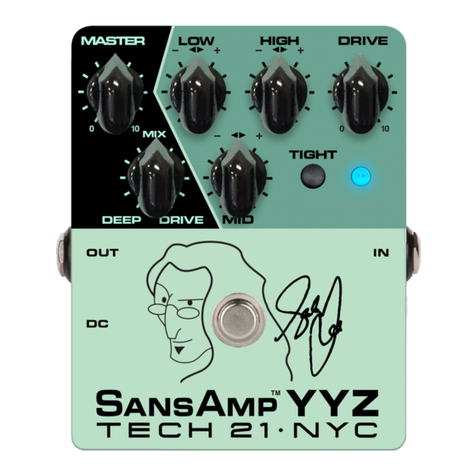
tech21
tech21 SansAmp YYZ User manual
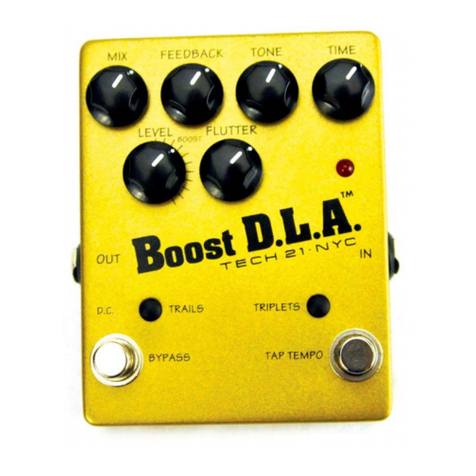
tech21
tech21 Boost D.L.A User manual



